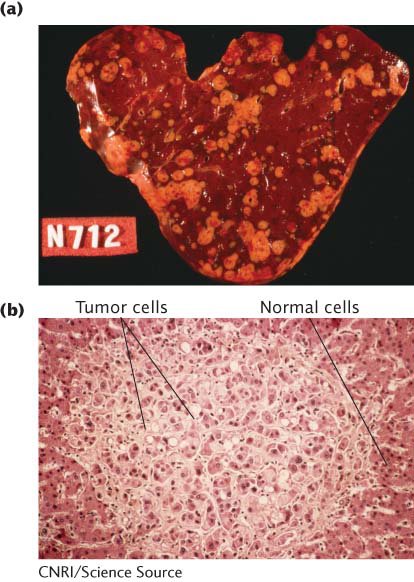16.1 Cancer Is a Group of Diseases Characterized by Cell Proliferation
One of every five people in the United States will die from cancer, and cancer treatments cost billions of dollars per year. Cancer is not a single disease; rather, it is a heterogeneous group of disorders characterized by the presence of cells that do not respond to the normal controls on division. Cancer cells divide rapidly and continuously, creating tumors that crowd out normal cells and eventually rob healthy tissues of nutrients (Figure 16.2). The cells of an advanced tumor can separate from the tumor and travel to distant sites in the body, where they may take up residence and develop into new tumors. The most common cancers in the United States are those of the breast, prostate gland, lung, colon and rectum, and blood (Table 16.1).

| Type of cancer | New cases per year | Deaths per year |
|---|---|---|
| Breast | 235,030 | 40,430 |
| Prostate | 233,000 | 29,480 |
| Lung and bronchus | 224,210 | 159,260 |
| Colon and rectum | 136,830 | 50,310 |
| Lymphoma | 79,990 | 20,170 |
| Melanoma | 76,100 | 9,710 |
| Bladder | 74,690 | 15,580 |
| Uterus corpus | 52,630 | 8,590 |
| Leukemias | 52,380 | 24,090 |
| Pancreas | 46,420 | 39,590 |
| Oral cavity and pharynx | 42,440 | 8,390 |
| Liver | 33,190 | 23,000 |
| Brain and nervous system | 23,380 | 14,320 |
| Stomach | 22,220 | 10,990 |
| Ovary | 21,980 | 14,270 |
| Uterine cervix | 12,360 | 4,020 |
| Cancers of soft tissues including heart | 12,020 | 4,740 |
| All cancers | 1,665,540 | 585,720 |
|
Source: American Cancer Society, Cancer Facts and Figures, 2014 (Atlanta: American Cancer Society, 2014), p. 6. |
||